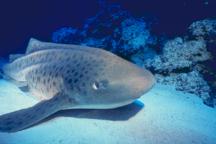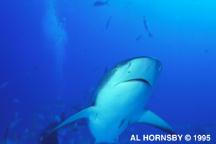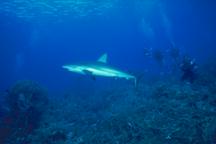![]()
Diving with sharks is always a humbling experience. Unless, of course, you happen to be a teenager who fancies himself some kind of 'expert' on the subject. As Alfred E. Neuman put it, "Experience is something you never have until just after you needed it." ... But I'm getting ahead of my story.
I grew up along the central Queensland coast, near the southern extreme of the Great Barrier Reef. Like most Aussies, I loved to play in the ocean, despite my culturally inherited paranoia about sharks. When I set out to exorcise my fear of sharks by learning as much as I could about them, my motivation shifted from self-preservation to pure fascination. By the time I was 15 - like most teenagers, I suppose - I enjoyed the delusion that I knew just about everything worth knowing and was virtually indestructible, as well. It was during this stage that I first read Richard Johnson and Donald Nelson's classic 1973 paper in Copeia, describing their work in Eniwetok studying the so-called 'agonistic display'* of the grey reef shark (Carcharhinus amblyrhynchos). When Johnson or Nelson persistently chased a grey reef, the shark consistently signaled its readiness to attack by way of a distinctive, hunch-backed swimming posture punctuated by a raised snout, lowered pectoral fins, and an exaggerated rolling swimming style. Since we had the same species of shark off the Queensland coast and I was particularly interested in shark behavior, I decided I just had to see this display for myself. So, planning to imitate everything the learned scientists did in Micronesia, I went out to the Reef to slag off our local grey reef sharks.
 Much to my disappointment,
our grey reef sharks didn't display - they simply accelerated for about 15 meters, then
continued on their way like a James Bond martini: shaken, not stirred. Undaunted, I knew
that agonistic displays were widespread among social vertebrates and reasoned that this
species can't be the only one. I knew precisely where and when I could intersect a
1.7-meter silvertip shark (Carcharhinus albimarginatus) with a distinctively notched
dorsal fin, and deemed she would make a good subject for further experimentation. At least
I had the good sense to realize that I was about to enter a kind of scientific
nether-land. I was about to 'attack' one of the fastest and best-armed creatures that swim
and since no one could tell me what to expect of her behavior, I decided I wanted
something heavy and solid between my body and the shark's jaws. It seemed that a Diver
Propulsion Vehicle (DPV), a kind of torpedo with handles used to tow a diver through the
water, was the perfect choice. I planned to use the DPV only to chase the shark, switching
it off as soon as the shark started to display.
Much to my disappointment,
our grey reef sharks didn't display - they simply accelerated for about 15 meters, then
continued on their way like a James Bond martini: shaken, not stirred. Undaunted, I knew
that agonistic displays were widespread among social vertebrates and reasoned that this
species can't be the only one. I knew precisely where and when I could intersect a
1.7-meter silvertip shark (Carcharhinus albimarginatus) with a distinctively notched
dorsal fin, and deemed she would make a good subject for further experimentation. At least
I had the good sense to realize that I was about to enter a kind of scientific
nether-land. I was about to 'attack' one of the fastest and best-armed creatures that swim
and since no one could tell me what to expect of her behavior, I decided I wanted
something heavy and solid between my body and the shark's jaws. It seemed that a Diver
Propulsion Vehicle (DPV), a kind of torpedo with handles used to tow a diver through the
water, was the perfect choice. I planned to use the DPV only to chase the shark, switching
it off as soon as the shark started to display.
The display I got was not what I expected. When I got within about 3.5 meters from the silvertip, she accelerated away ... turned ... and came charging back with her pectoral fins held stiffly downward; when the shark was about 3.5 meters away, she turned broadside to me, lowered her tail, and 'shivered' her entire body. This action reduced the shark's forward swimming efficiency and continued until her pelvic fins were just passing my chest ... then, pectorals still strongly depressed, she accelerated away at Warp Factor 8. Eventually I was able to conduct a total of 28 trials with silvertips, provoking at least five individual sharks; 8 of those trials (28.6%) resulted in a display just like the one described above - twice the stressed shark raked the nose cone of my DPV with the upper jaw teeth before departing - but the remainder resulted in nothing more dramatic than the shark simply swimming away. It was surprising to me that, even when chased, silvertip sharks were reluctant to attack me. But the displays themselves, when analyzed, were even more interesting.
 The agonistic display of the
silvertip shark shared some common features with that of the grey reef, namely: pectoral
fin depression, flank displaying, reduced forward swimming efficiency, an overall increase
in muscular tension, and a rapid withdrawal. These features - especially the rapid
withdrawal - plus their highly stereotyped nature are consistent with defensive rather
than offensive responses to what must surely be a novel situation (being chased by an
over-confident teenager riding a DPV). The silvertip display also featured some elements
that the grey reef does not, namely vertical depression of the tail, and - most
spectacularly - shivering the body. The shiver behavior, combined with turning broadside,
made it difficult to accurately estimate a displaying shark's length and drew attention to
the white-tipped fins that give this species its common name. Silvertip agonistic displays
are highly stereotyped (performed the same way each time). When I tried another species,
the blackfin reef shark (Carcharhinus melanopterus), I got yet another species-specific
display.
The agonistic display of the
silvertip shark shared some common features with that of the grey reef, namely: pectoral
fin depression, flank displaying, reduced forward swimming efficiency, an overall increase
in muscular tension, and a rapid withdrawal. These features - especially the rapid
withdrawal - plus their highly stereotyped nature are consistent with defensive rather
than offensive responses to what must surely be a novel situation (being chased by an
over-confident teenager riding a DPV). The silvertip display also featured some elements
that the grey reef does not, namely vertical depression of the tail, and - most
spectacularly - shivering the body. The shiver behavior, combined with turning broadside,
made it difficult to accurately estimate a displaying shark's length and drew attention to
the white-tipped fins that give this species its common name. Silvertip agonistic displays
are highly stereotyped (performed the same way each time). When I tried another species,
the blackfin reef shark (Carcharhinus melanopterus), I got yet another species-specific
display.
In pursuing an understanding of shark behavior, I have been very lucky on several counts. I am fortunate to have been able to continue the grass-roots studies I began as a cocky teenager through my marine biological training and into my professional career. Since their humble beginnings, I have expanded my study of shark agonistic displays to a total of 22 species, including the Galapagos shark (C. galapagensis), sandbar shark (C. plumbeus), Caribbean reef shark (C. perezi), scalloped hammerhead (Sphyrna lewini), spiny dogfish (Squalus acanthias), and the bluntnose sixgill shark (Hexanchus griseus). In the course of these researches, I have been 'attacked' 81 times - though bitten only 4 times - so I am also very lucky not to have had any of my favorite body parts 'edited'. But most of all, I am fortunate to have spent thousands of hours in the water with sharks of many different species under a wide variety of diving conditions. Based on my findings to date, I can offer the following tentative conclusions about shark behavior in general and body language in particular.
 Sharks are socially complex.
Although they do not seem to be territorial, many reef-dwelling sharks have well-defined
home ranges which they move through in a highly predictable manner. Individual sharks seem
to have a pretty good sense of their own body size and a well-developed sense of
kinesphere or 'personal space'. In most species I have studied thus far, this personal
space is roughly spherical with a radius of about two body lengths. When a diver attempts
to get within a shark's kinesphere, many species will indicate that they are on the verge
of either attacking or fleeing by way of an agonistic display. These displays seem to be
derived from actions associated with physically overpowering prey and are highly
stereotyped, containing one or more species-specific elements as well as common features
such as pectoral fin depression, a change in swimming style, and an overall increase in
muscular tension. If the diver maintains eye contact with a displaying shark and backs
away, the shark will almost always seize the opportunity to make good its escape; if a
diver persists in approaching a displaying shark, a lightening-fast, slashing attack may
result, followed by a rapid retreat. Make no mistake about it: you cannot defend yourself
against the mind-stutteringly fast attack that precipitates from these situations.
Discretion is the better part of staying alive and in one piece.
Sharks are socially complex.
Although they do not seem to be territorial, many reef-dwelling sharks have well-defined
home ranges which they move through in a highly predictable manner. Individual sharks seem
to have a pretty good sense of their own body size and a well-developed sense of
kinesphere or 'personal space'. In most species I have studied thus far, this personal
space is roughly spherical with a radius of about two body lengths. When a diver attempts
to get within a shark's kinesphere, many species will indicate that they are on the verge
of either attacking or fleeing by way of an agonistic display. These displays seem to be
derived from actions associated with physically overpowering prey and are highly
stereotyped, containing one or more species-specific elements as well as common features
such as pectoral fin depression, a change in swimming style, and an overall increase in
muscular tension. If the diver maintains eye contact with a displaying shark and backs
away, the shark will almost always seize the opportunity to make good its escape; if a
diver persists in approaching a displaying shark, a lightening-fast, slashing attack may
result, followed by a rapid retreat. Make no mistake about it: you cannot defend yourself
against the mind-stutteringly fast attack that precipitates from these situations.
Discretion is the better part of staying alive and in one piece.
It is important to stress that my studies are on-going and any conclusions offered here must be considered provisional at best. However, it is interesting to speculate about why shark agonistic displays have unique, species-specific elements combined with features common to all species studied to date. I suspect that since sharks are apex predators which compete most strongly against members of their own species, the species-specific elements to their agonistic displays act as a kind of 'signature' directed at members of the same species. Since an inshore area --especially a coral reef-- may support numerous species of shark, it is possible that the common features of these agonistic displays serve to communicate defensive threat between species - in much the same way that people of vastly different cultures can recognize and respond to a laugh, which is performed the same way from Australia to Zimbabwe. Who knows?
But I firmly believe that sharks do much more than threaten one another. Agonistic displays have the benefit that they are fairly unambiguous (if a fish wiggles funny then proceeds to bite you in the arse, odds are you've slagged it off somehow). I hope eventually to use my experience in studying shark agonistic displays to explore more subtle aspects of shark social life, such as recognition among individuals and how they assess whether a given shark is sexually receptive or not. And, having been thumped, scuffed, bruised, slashed, and bitten a few times in the pursuit of a better understanding of shark behavior, I plan to be much more cautious and protect myself against further injuries.
I suppose it's fair to say that I'm still a kid playing in the ocean ... only I'm more careful than I used to be, my questions have become a little more sophisticated, and I'm no longer as certain of my conclusions. As Robert Heinlein's character Lazarus Long put it, "Live and learn, or you don't live long!"
* Agonistic Display (n): a ritualized behavior or series of behaviors elicited in competitive contexts to communicate aggression or submission, usually within species.